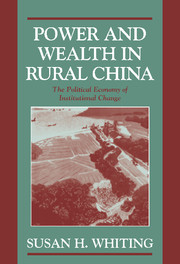Book contents
- Frontmatter
- Contents
- List of Maps, Figures, and Tables
- Preface
- 1 Explaining Institutional Change
- 2 The Maoist Legacy in Rural Industry
- 3 Incentive Structures and Local Cadre Behavior
- 4 Incentives, Constraints, and the Evolution of Property Rights
- 5 Stasis and Change in Extractive Institutions
- 6 Credit Allocation and Collective Organizational Structures
- 7 The Political Economy of Institutional Change
- Appendix
- Bibliography
- Index
5 - Stasis and Change in Extractive Institutions
Published online by Cambridge University Press: 30 September 2009
- Frontmatter
- Contents
- List of Maps, Figures, and Tables
- Preface
- 1 Explaining Institutional Change
- 2 The Maoist Legacy in Rural Industry
- 3 Incentive Structures and Local Cadre Behavior
- 4 Incentives, Constraints, and the Evolution of Property Rights
- 5 Stasis and Change in Extractive Institutions
- 6 Credit Allocation and Collective Organizational Structures
- 7 The Political Economy of Institutional Change
- Appendix
- Bibliography
- Index
Summary
LOCAL extractive institutions evolved in response to a complex set of incentives and constraints. While all local governments faced a common revenue imperative, their particular institutional arrangements for revenue extraction were shaped by the constraints associated with the local structure of property rights. Different structures of property rights were associated with different levels of transaction costs and different distributions of bargaining power within the local community. Under collective forms of ownership, information about the resources of firms was held by agents situated within a local hierarchy headed by local state officials. Collective ownership entailed lower costs of revenue extraction to the local state, because it provided institutional arrangements that internalized transactions, creating “enforceable norms for the transmission of information” (Evans 1995:26). By contrast, under private forms of ownership, information was held within a firm that was at arm's length from the local state, raising the cost of revenue extraction. As Nicholas Van de Walle (1989:607) points out, information costs are likely to be higher for state regulation than for state ownership, because regulation of an industry requires the acquisition of such extensive information about an industry's costs and technologies. Therefore, as private firms became an increasingly important part of the local economy, local state officials had an incentive to innovate, developing new institutional arrangements to cope with those costs.
- Type
- Chapter
- Information
- Power and Wealth in Rural ChinaThe Political Economy of Institutional Change, pp. 176 - 225Publisher: Cambridge University PressPrint publication year: 2000



